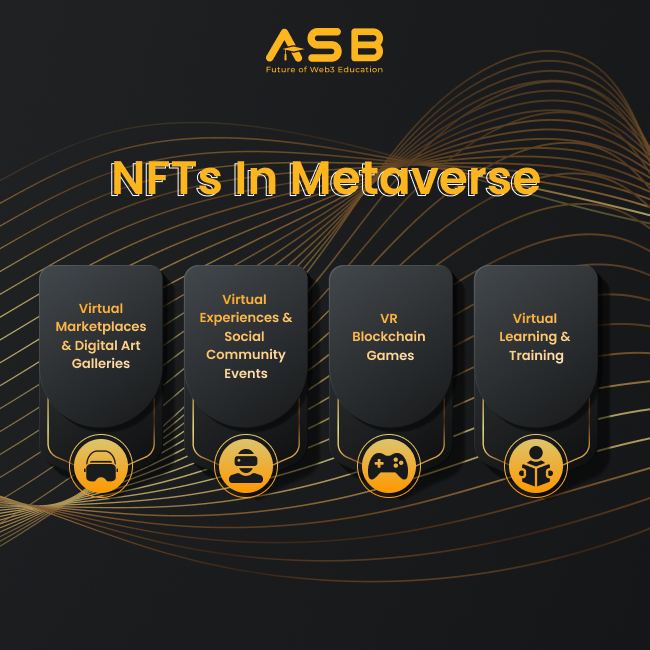Navigating the Emerging Digital Landscape: NFTs Vs Metaverse
Since the advent of web3 technologies, terms like ‘NFT’ and ‘metaverse’ have generated a great buzz around the world. While the concept of metaverse existed long before the creation of NFTs, the latter does seem to have a radical impact on the former. Today, there is a high demand for metaverse professionals and NFT developers.
In this article, we explore how NFTs differ from metaverse, their interplay, and related industry trends.
Introducing NFTs and Metaverse
NFTs (non-fungible tokens) are digital assets built and minted on blockchain. As the name suggests, these are exclusive and distinct. NFTs are used to represent several types of digital resources, such as tweets, videos, music, artwork, gaming avatars, virtual properties, social club tickets, etc.
Being strongly secure and transparent, NFTs are seen as a better alternative for verification of data ownership. In 2023, the average revenue per user in the NFT market is US$114.8. It is projected that by 2027, there will be 19.31 million NFT users. Nowadays, NFT smart contract developers are counted among the highest-paid tech employees, credit to the ever-increasing popularity of these digital assets.
On the other hand, metaverse refers to a three-dimensional virtual environment, where users can communicate and interact with digital content. Though the metaverse is based on augmented reality (AR) and virtual reality (VR), blockchain tech provides further support for its asset security, decentralization, and interoperability. It is also perceived as an evolved version of the internet and similar social technologies.
Metaverse has immense potential to contribute to sectors like gaming, entertainment, military, healthcare, tourism, education, real estate, etc. In 2023, the worldwide metaverse market was worth around $83.9 billion and is projected to expand at a compound annual growth rate (CAGR) of 48% from 2023 to 2030.
Differences Between NFT and Metaverse
Relative to NFTs, metaverse is clearly a wide-ranging technology that spans all sorts of digital assets, including centralized and decentralized ones. Despite their association, there is a need to know their differences in order to understand their roles in the web3 ecosystem.
Here’s a brief of the various aspects that set NFTs and metaverse apart:
Genesis
The idea of NFTs originated with the launch of blockchain technology and cryptocurrencies. Though the first NFT came out in 2014, it garnered tremendous attention after the introduction of the largest blockchain Ethereum in 2015. Later on, NFT projects like Bored Ape Yacht Club and CryptoPunks pushed the concept further.
The inception of the metaverse can be traced back to the 1992 science fiction novel ‘Snow Crash’. Thereafter, the first virtual world ‘Second Life’ was created in 2003, followed by several other metaverses.
Underlying Technology
NFTs are essentially virtual digital collectibles or tokens that can be traded and exchanged and serve as a storage value. These are stored on the blockchain and follow the rules defined by the smart contracts.
Whereas, the metaverse is a virtual world, devised to provide immersive and interactive digital experiences, that are simulated versions of the real world. Initially built with AR, and VR technologies, the current metaverse realm also relies on Artificial Intelligence (AI) and blockchain. Metaverse aims to become an open, collaborative, and highly dynamic form of the internet.
Usage
NFTs primarily function as a means of owning and trading unique digital assets. These are created on blockchain platforms, bought via related marketplaces, stored on blockchain, and accessed via crypto wallets or similar other platforms. NFTs have the potential to grow into a financial source as well as be a part of the decentralized economy.
However, the metaverse mainly works as a medium for social, gaming, and entertainment usage. Here, people can play games, attend events, interact with each other, and experience real-world environments in a virtual set-up. No doubt, metaverse training courses were already in place, before the development of blockchain space. Along with the progress in the NFT landscape, the metaverse can prove a useful tool for establishing a creator economy.
Applications of NFTs in Metavers
The tokenization of virtual assets in the metaverse has given rise to a ground-breaking mode of digital commerce. Apart from being an identification and accessibility source, NFTs fulfill multiple other objectives, as explained below:

Virtual Marketplaces & Digital Art Galleries
As digital assets showcasing artwork and similar collectibles, NFTs are unique limited-edition items displayed in virtual marketplaces of the metaverse. Owing to their inherent nature of being immutable and tamperproof, NFTs provide an additional layer of security and control in terms of accessibility. These are extremely valuable and can also be exchanged for other tokens and cryptocurrencies.
The Sandbox and Decentraland are popular decentralized metaverse platforms, exhibiting NFT art galleries and earning millions of dollars.
Virtual Experiences & Social Community Events
NFT acts as passes or identity badges to exclusive forums, chat rooms, virtual conferences, exhibits, and concerts. In these real-time social events conducted on metaverse platforms, people get to connect, collaborate, collect virtual rewards, and share interests. Since NFTs denote a user’s attendance, they can also facilitate metaverse training workshops.
Online gaming has progressed from being pay-to-earn to play-to-earn platforms. This has given a boost to participation and competition in the gaming environment.
Virtual Learning & Training
Metaverse has been contributing to the education sector for over a decade. The incorporation of blockchain technologies paves the way for degrees and diploma certificates to be awarded as NFTs by educational institutions. With more advancements, NFTs can be used to back up student databases and distribute rewards.
Lately, a number of organizations have been offering metaverse certifications, considering the growing demand for new-age technologies. Among these, ASB (Antier School of Blockchain) rules the roost, with a one-of-the-kind Metaverse Foundation Program, designed to create expert professionals in the upcoming IT sector.
Final Thoughts
The adoption of metaverse and NFTs is in an early phase, yet some of the well-known organizations (Nike, Microsoft, Warner Music Group, Gucci, etc.) are already making huge investments in metaverse and NFT technology. As the global audience becomes more aware of this fast-emerging and professionals get upskilled with reliable metaverse courses, the day isn’t far when every industry has its own metaverse.
